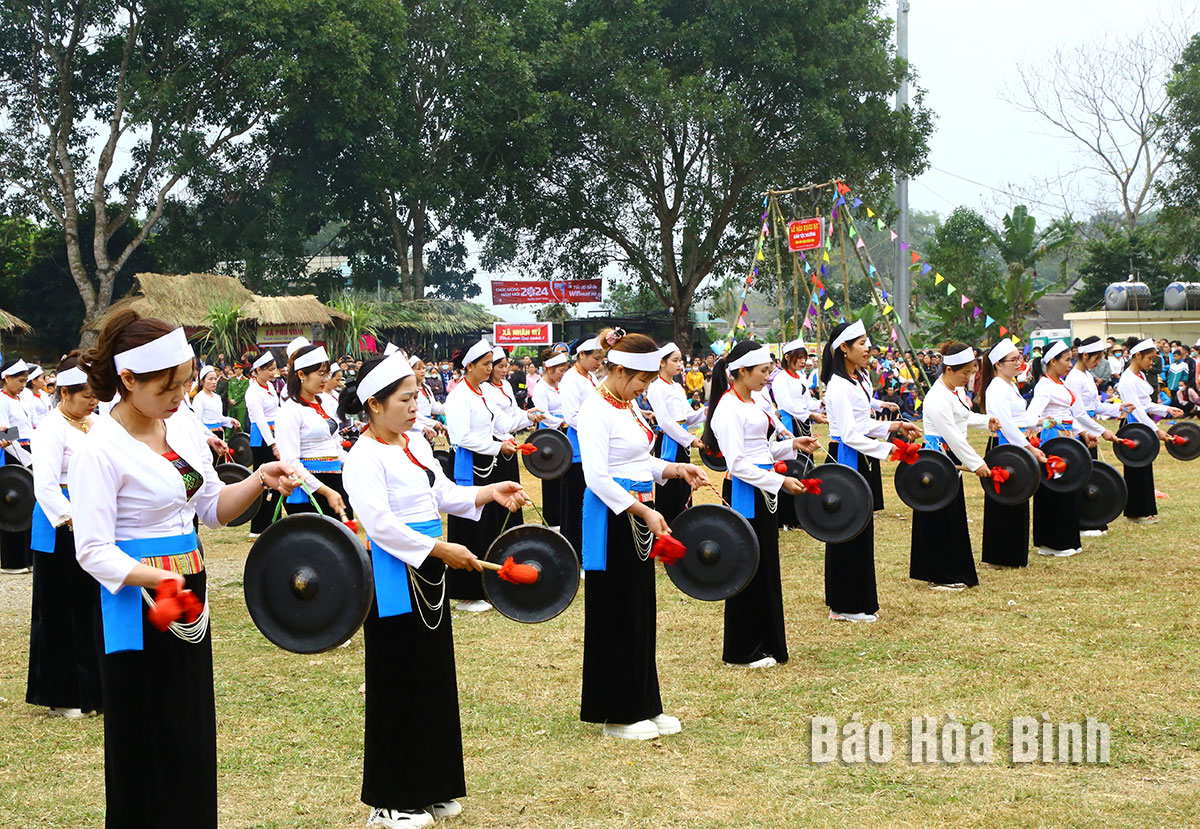



Muong gong art has been preserved and promoted during the major provincial and local festivals. For example, in the photo, it is Khai Ha Festival of the Muong ethnic people in Hoa Binh province in 2024 held in Phong Phu commune (Tan Lac).
Ms. Nguyen Thi Dung from Vinh Dong commune (Kim Boi) says: As a child born and raised in Muong Dong, I have been listening to the sound of gongs during festivals, Tet, and the village celebrations since I was young. As an adult, even though I got married far away, the sound of gongs during festivals and Tet always urges those who are far from home to return and reunite with their family and neighbors.
According to Mr. Bui Thanh Binh, the Director of the Museum of Muong Cultural Heritage, group 6, Thai Binh ward (Hoa Binh City), Muong gongs are a unique cultural form that embodies the sacred and mystical aspects of Muong folk culture and life. Over thousands of years, Muong gongs have shaped the unique cultural identity of Muong people. Thus, Muong gongs are considered the treasures, the sacred soul of Muong ethnic group. Gongs are present in every Muong household, integrated into the daily spiritual and living activities for thousands of years. As a family museum, his family has collected over 6,000 artifacts about Muong people's lives, including many Muong gongs. He also teaches Muong gongs and folk music to the people within and outside Hoa Binh province.
In the treasure of Muong cultural heritage, gongs play a very important role, closely linked to the cultural, spiritual, and religious life of the people from birth to death. Gong culture is considered the soul of Muong people, a sacred object symbolizing the prosperity in the material and spiritual life of each family and the Muong community. The gong culture of the Muong people in Hoa Binh has its unique characteristics, preserving the distinctive values of the ethnic culture.
According to a survey in 1999, in the whole province there were only 3,830 gongs, a significant decrease compared to that of previous periods. This decline was due to several reasons: the war, the insufficient awareness of the gongs' value, poverty, and the hunt for antiques. By 2010, the appropriate authorities recorded 9,960 gongs across the province, owned by various organizations and individuals in the community. To preserve and promote the value of Muong gongs, the province organized the first Muong Gong Festival in 2011 and the second in 2016, commemorating the 125th and 130th anniversaries of the province's founding. These festivals were recognized by the Vietnam Record Book as the largest gong performances in Vietnam. Muong Gong Festival in Hoa Binh is a unique folk cultural activity characteristic of Muong people.
In 2016, the art of Muong gongs in Hoa Binh was included in the national intangible cultural heritage list by the Ministry of Culture, Sports, and Tourism. Following the province's policy on preserving Muong gongs and with the attention of various levels, sectors, and the public, the number of gongs in the province has significantly increased. Muong gongs are widely used in the community activities, many cultural and political events in the province, and some regional and national events. The melodies of gongs and the cultural space of Muong gongs in Hoa Binh have impressed tourists, especially international visitors to Hoa Binh.
However, facing the cultural changes and the explosion of information technology, the cultural heritage of Muong gongs is at high risk of fading, leading to a lack of interest in gong culture among some Muong people, especially the younger generation. Recently, the province has issued a plan to preserve and promote the cultural value of Muong ethnic group and the"Hoa Binh Culture” from 2023 to 2030. This plan includes the evaluations of the results, the current conditions, and the specific solutions to preserve and promote the cultural and artistic heritage of Muong gongs in today's and future life. It emphasizes the importance of maintaining and promoting Muong gong art in connection with tourism development, enhancing the promotion and advertising of the value of Muong gongs, and continuing to use gongs in major provincial and local festivals. Additionally, it involves teaching Muong gong art to the younger generation.